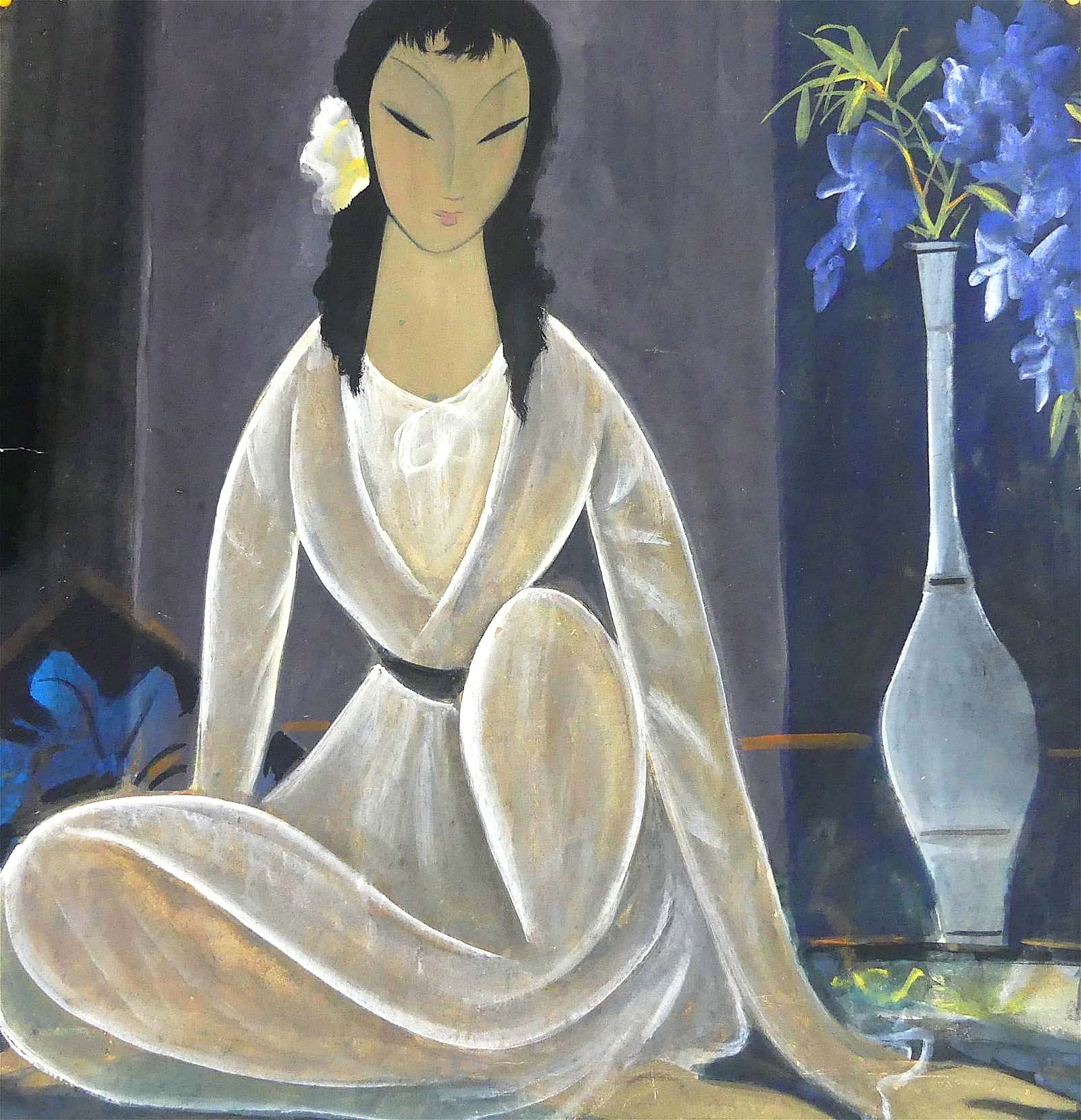
One of two Twentieth Century Chinese watercolors that tied for the day’s highest price, $70,400. It had been done by Lin Fengmian.
Review & Onsite Photos by Rick Russack
REHOBOTH, MASS. — Chinese watercolors and Asian ceramics. China trade paintings. A 55-pound copper ingot from the 1622 wreck of the Atocha. Tiffany and Pairpoint glass. A Frieda Kahlo archive. Scrimshaw and marine items. Silver and fine jewelry. Folk art and decoys. Chinese carved furniture and Oriental carpets. A collection of Royal Worcester porcelain. That’s just the start of describing what was included in Americana Auctions’ Winter Estates Auction on January 28. The sale was fast-paced and live; when the auction began, many more than 600 people were watching on LiveAuctioneers, with more on Invaluable. Last year, the company made sales to customers in about 20 foreign countries; several items in this sale went to international buyers as well. Catalog descriptions are detailed, and numerous photos are included.
At their sale on January 15, 2023, the company, owned by Ed Tessier and managed by Richard Shute, sold a Twentieth Century Chinese watercolor for $375,000; this sale included more material from that collection, including two large watercolors by Lin Fengmian (1900-1991), who was originally named Lin Fengming. The estate was that of Al and Aiko Hydeman, who summered in Martha’s Vineyard. He was a successful businessman and he and his Japanese wife traveled extensively, spending winters in Hong Kong in the 1950s and 1960s, where this collection was assembled. These two watercolor and ink works remained in the family home after Hydeman’s death in 1992.
Fengmian is considered a pioneer of modern Chinese painting for his blending of Chinese and Western styles. Born in China, he spent his early years in France, returning to China in 1926. Unfortunately, many of his works were destroyed during the Sino-Japanese war; more were lost during China’s Cultural Revolution, when he was jailed for four years. The two examples of his work each sold for $70,400, the highest prices of the sale. One showed a Chinese lady in a white dress sitting beside a large vase with blue flowers. The other depicted a Chinese lady in an interior setting, seated on the floor. Both were of similar size, 26 by 25½ inches and both bore the seal of the artist.
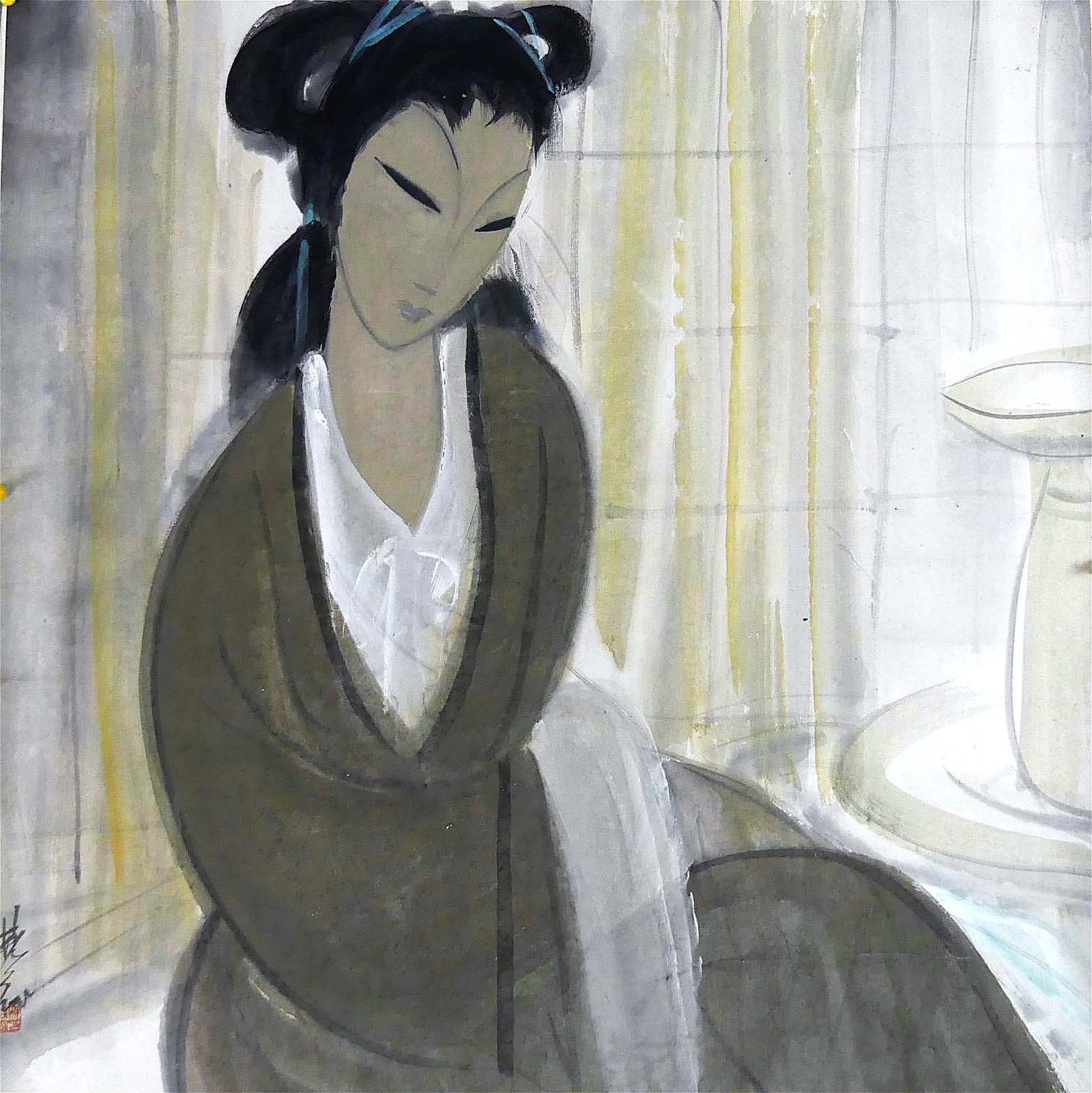
This was the second of the Lin Fengmian watercolors to sell for $70,400, tying for the high price of the day. The artist returned to China from France in 1926 and unfortunately many of his paintings were destroyed during war and Mao Zedong’s Cultural Revolution.
Not all the Chinese watercolors from the Hydeman collection brought five figure prices. Some sold for less than $1,000, including a mountainous landscape with a village, done by C.C. Wong, which sold for $768. Of the half-dozen China trade paintings, the most popular with bidders was one titled on the reverse, “Painting of the Foreign Factories, Canton.” Numerous ships flying flags were depicted in the harbor, which was flanked by buildings. It realized $4,480.
The Chinese porcelains on offer included a Nineteenth Century Rose Medallion barrel-form garden seat with genre scenes of birds, flowers and butterflies; it went out for $1,536. Several pieces of Chinese carved hardwood furniture included a fire screen inset with an embroidered silk panel in the “hundred bird” design, showing numerous brightly colored birds, a flowering tree, a peacock and more. It sold for $5,120. A few small, heavily carved hardwood tables with inlaid marble tops, sold mostly in the range of $600.
A fine collection of Japanese satsuma porcelain did well, with most pieces exceeding estimates. A 24-inch-tall Meiji period vase painted in the Thousand Face design earned $9,600. It was certainly an eye-catching piece and had the Shimatzu mark. Another eye-catching satsuma piece was a moon vase with a circular base and elaborate hand-painted and gilt decoration of dragons, birds, flowers, fans, latticework and more that earned $3,584. Several pieces of Japanese cloisonne included a Meiji period ginbari bowl with a bright orange and brown koi fish on a bright blue enamel ground. It brought $3,200.
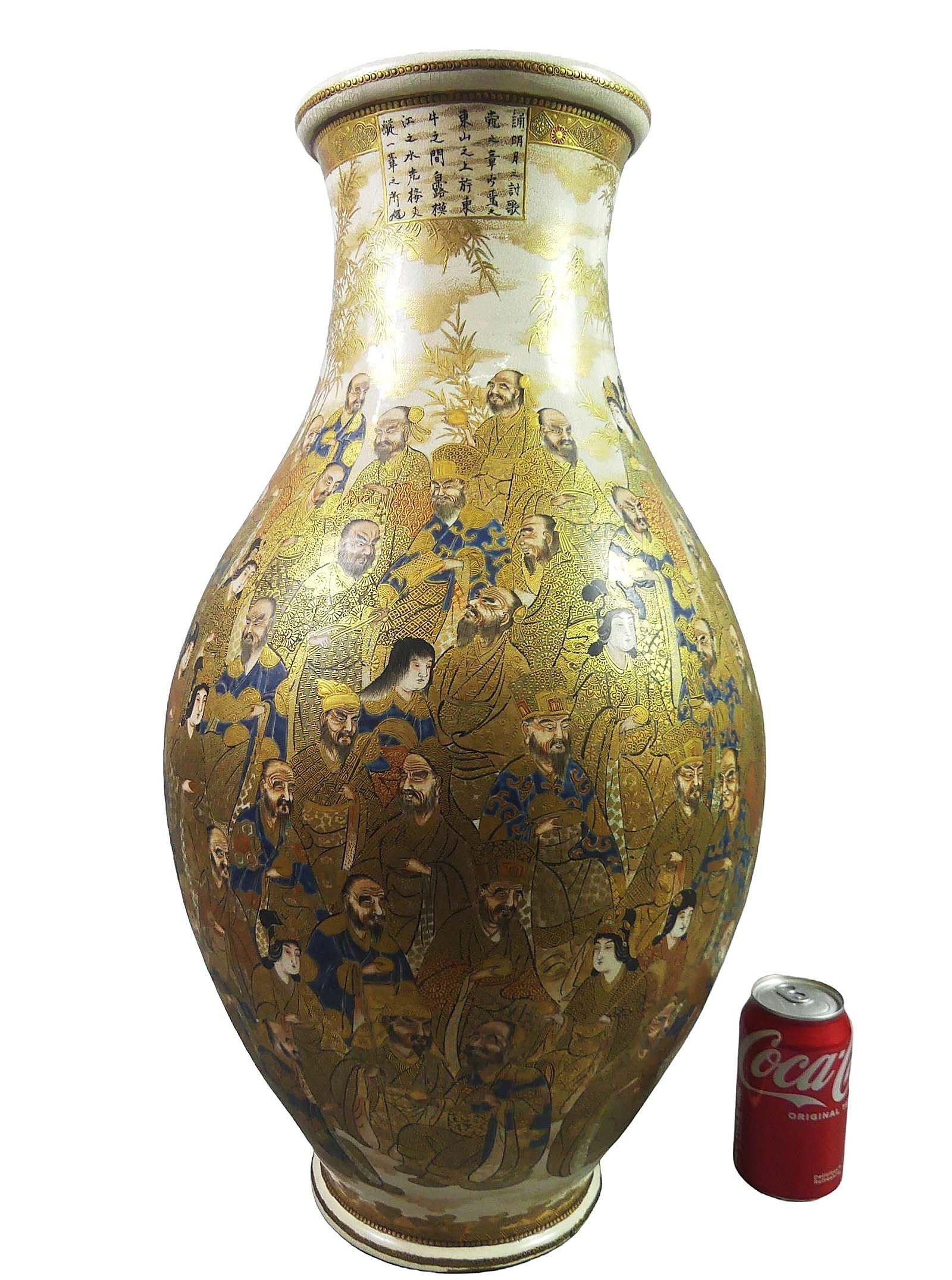
Several pieces of Chinese and Japanese ceramics were included in the sale. The Satsuma selection was led by this 24-inch-tall Meiji period vase decorated in the Thousand Faces design. It had a Shimatzu Satsuma mark and other characters on the underside. There were two panels around the neck with Asian characters. In fine condition, it sold for $9,600.
The furniture category included Nineteenth Century English and American pieces. The highest price was achieved by a mahogany dwarf-case clock with a painted metal dial signed “Joshua Wilder, Hingham, 1820.” Selling for $12,800, the clock stood 44 inches tall, and its three finials were replacements. An unusual Hepplewhite mahogany deep-drop-leaf dining table exceeded expectations as it sold for $1,920. The top and each of the 2-foot-wide drop leaves were made from single boards. Bringing $1,664 was a serpentine North Shore Hepplewhite sideboard with figured mahogany veneer.
The collection of art glass included works by Tiffany, Mount Washington, Pairpoint and French cameo glass that had been purchased from many of the leading dealers of the day, including Sonia Paine, whose original price labels remained on some pieces. Collecting interests have changed since those days, allowing today’s aficionados to acquire fine examples at reasonable prices. Two “puffy” Pairpoint lamps led the selection. One was in the Azalea pattern and was on a metal base embossed with azaleas; it earned $4,992. The other, a small boudoir lamp in the Pansy pattern brought $2,304. A small green and gold iridescent Tiffany Favrile vase with a ruffled mouth earned $1,280. A Tiffany Favrile candlestick lamp, with shade and chimney, 15 inches tall, realized $1,216.
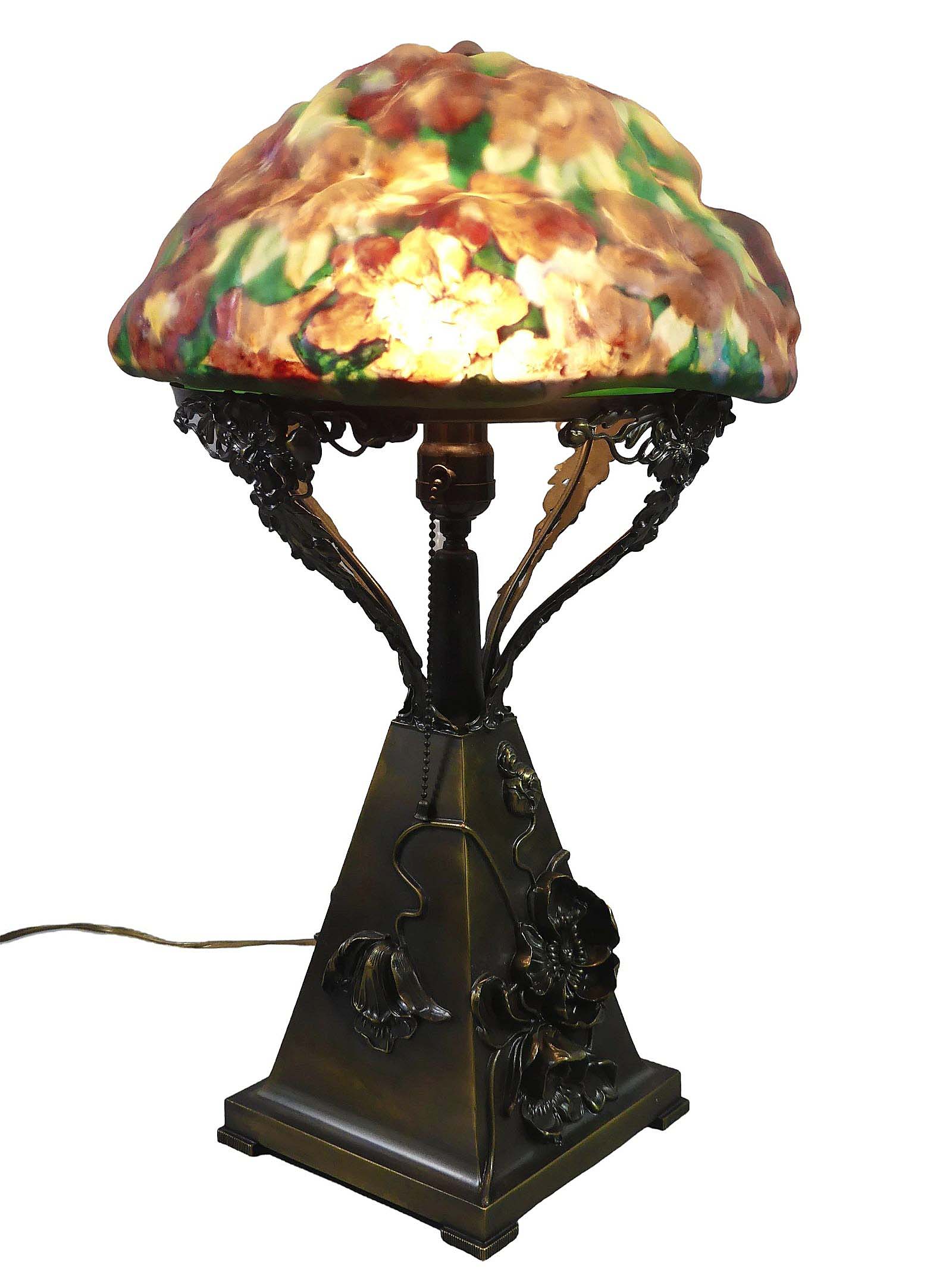
The sale included a large selection of art glass, including Pairpoint puffy lamps. This Azalea pattern shade was on a metal base embossed with azaleas and lit up to $4,992.
The top selling piece of French glass was a small painted Daum Nancy egg-shaped vase, only 2 inches tall, which sold for $2,080. An exceptional Moser enameled pitcher with a salamander-form handle and elaborate multicolored floral decoration, including a large bird and a bumble bee, brought $3,328. A signed bronze Tiffany Studios Octopus pattern inkstand went out at $2,280. Pieces by Moser, Webb, Galle and Stevens & Williams also did well. After the sale, Rich Shute commented that the art glass market seemed to be recovering as many pieces sold above estimates.
The marine offerings were extensive and varied and included the China trade paintings mentioned above, ship portraits, scrimshawed whale’s teeth, sailor’s valentines made of shells, half-hull models and whalebone walking sticks. As expected, the highest price of the selection was earned by a Narwhal tusk, measuring more than 7 feet long, that was mounted on solid mahogany plaque slightly larger than the tusk. The largest known examples of Narwhal tusks are about 9 feet long and “tusk” is not really the correct term — they are enlarged teeth of male whales; some writers speculate that medieval tales of unicorns were inspired by these tusks. The example in the auction came with a provenance dating it to 1840 and sold for $17,920.
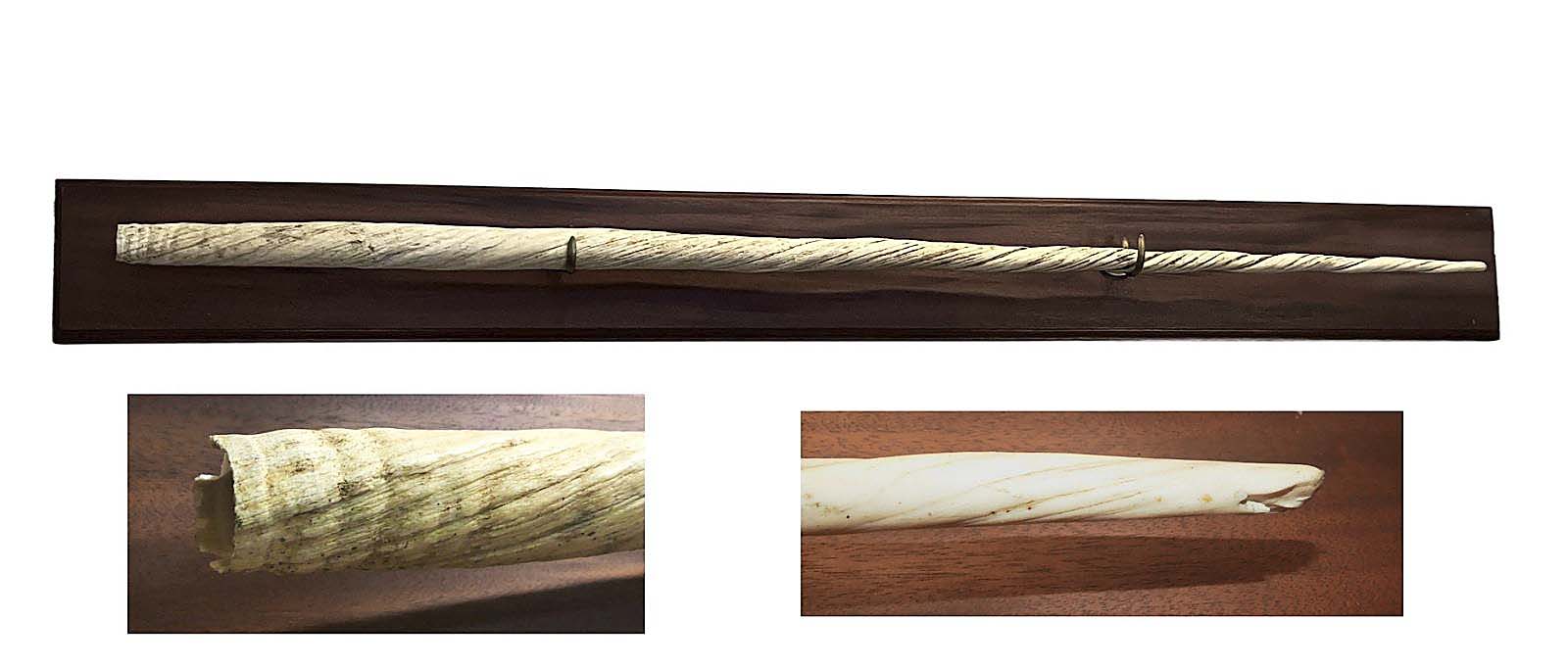
This narwhal tusk measured about 7 feet long and earned $17,920. It had provenance dating it to about 1840.
Scrimshawed whale’s teeth were topped by a Nineteenth Century example with one side depicting two American warships, each flying a US flag and with an American eagle on the other side. It brought $4,736. A 3-foot-long laminated half-hull model of a whaling ship cruised to $780. A shell sailor’s valentine signed “B.A. Woodman ’84” topped off at $4,992. It included a 4-inch circular inset of a mermaid signed “R. Cahoon.” Woodman worked with Cahoon, but the catalog, conservatively, stated that they could not guarantee the mermaid to be the work of Ralph Cahoon as his wife, Martha, also worked in a similar style.
A unique assortment of work by Mexican artist Frida Kahlo (1907-1954), including a signed and dated drawing by her husband, Diego Rivera (1886-1957), came from an estate in Florida. Kahlo had health problems through much of her life and the offerings in this group included macabre images, including a self-portrait which sold for $12,800.
After the sale, Rich Shute commented, “We were pleased with the sale. We grossed more than $640,000. I was glad to see some strong prices for the art glass — that’s a segment of the market that has been weak. It was also good to see porcelains, like the Royal Worcester and the Meissen charger, which did especially well. The crowd in the gallery was small but that’s the way it is these days.”
Prices quoted include the buyer’s premium as reported by the auction house.
For additional information, www.americana-auction.com or 508-771-1722.




























